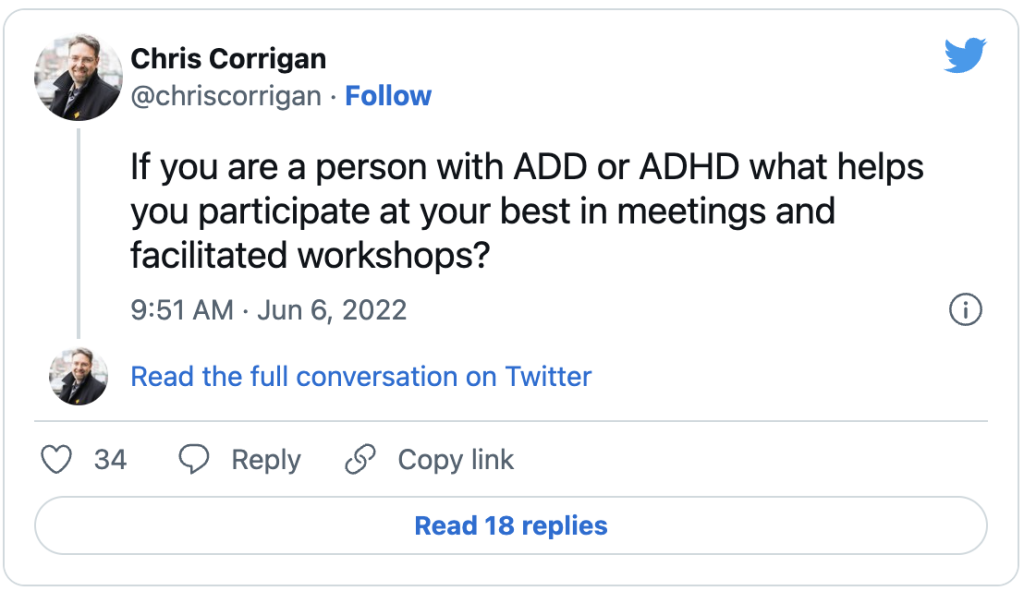Hello, AEA365 community! Liz DiLuzio here, Lead Curator of the blog. This week is Individuals Week, which means we take a break from our themed weeks and spotlight the Hot Tips, Cool Tricks, Rad Resources and Lessons Learned from any evaluator interested in sharing. Would you like to contribute to future individuals weeks? Email me at AEA365@eval.org with an idea or a draft and we will make it happen.
Please note that today’s blog was originally posted on Chris’s website and shared with permission.

I think I’m definitely feeling like my work is online for the foreseeable future. While I do have some face-to-face sessions lined up for the fall and winter, most of what I am going to continue to do is host meetings and learning online.
Even though I have been doing that since probably 2004 or so when I first started using Skype I continue to learn about how to make online environments more interesting and, most importantly, more accessible. From time to time I put out a call to help me learn about people’s needs and experiences. Back in June I asked folks with Attention Deficit Hyperactivity Disorder (ADHD) how to help them participate at their best and I got lots of useful answers. I trust that the people who answered self-identified as folks with ADHD.

Here’s what I learned:
Preparation
Right off the top folks said that it helps to have lots of advance notice of what is going to happen in the meeting. Now, this is a hard one for me, because I tend to improvise a lot and respond to the direction the group is going in. That’s fine for me because I’m the one with agency and I can control how much bandwidth I have and choose the stop the work for a break when it feels good to me. But for folks that regulate their participation and attention through structure and preparation that can be a tiring ride and quickly erodes their ability to absorb material, and participate in discussion. To that end, I’ll be trying these strategies:
- At the outset, let participants know how the day will unfold, what the break times are and what the discussion questions are likely to be. This helps people to think through material and to prepare and how to measure out their attention and participation.
- Help ground the meeting in a strong purpose. Let people know why this work is relevant to them. That helps folks stay engaged in the session. This is good invitation practice.
In-meeting participation
Working online is very hard on the attention span for most people. It asks a lot of us to stay in one place, watching a grid on a flat video screen, engaging in activities that seem repetitive. If something is going on too long, it’s easy for attention to wander and the brain to start focusing on other things. Good facilitation in general should be avoiding these situations, but for folks with ADHD, specifically these strategies were offered.
- In the session, provide a mix of activities to generate and support thinking. This could include a few minutes of silent reflection at the outset of a conversation so participants can think about the question before responding or engaging in dialogue and exploration.
- Present material in smaller chunks and allow for some time to absorb and for participants to ask themselves “what is new here?” Longer presentations start to lose the viewer especially if the material is dense or full of new terms and concepts. I’m massively guilty of this and so going forward I’m going to try to present material in short, ogical, connected chunks that allows for integration.
- For learning exercises, provide activities that invite people to explore a concept and even provide a little challenge that allows for a safe-to-fail probe and a little dopamine reward. This little post from Nadia is one that inspired “the creative challenge” as a part of my facilitation practice.
- Don’t allow a few people to go down rabbit holes at the expense of everyone else’s learning. This can often happen in a plenary session, so I try to have people go into small groups to process some of the things they are hearing and learning.
- Sticking to commitments is important. If there is a break at 10:30, break at 10:30. I know already from years of working with folks with diabetes that scheduled meal times are essential and can’t be missed. This is true of folks with ADHD as well.
- Provide visual maps for the content that is being discussed. How does this link to other stuff we have been doing? My partner Caitlin is really good at doing this, and contextualizing our current learning in a larger landscape of what we are doing. It’s like those recaps that come before TV episodes…”previously on Star Trek…”
- Use tools like polls to engage people’s thoughts in plenary and then open the floor for comments based on that. Using tools like Menti gives people a chance to reflect and offer some text and so you can hear from everyone and not just the one or two who manage to get their voices heard.
What to do afterwards
As my friend Christie Diamond reminded me years ago, “the conversations starts long before the meeting begins and it ends long after the meeting is over.” To that end, it’s helpful to have a few plans for how to continue to participate after the meeting is done. For many people, the brian keeps sparking and having somewhere to contribute insights that come later is helpful. To that end it’s useful to let participants know what they can do afterwards with their insights. If there is a way to contribute, provide an email address and let them know how long that channel is open for. In our courses we use Kajabi as a learning platform that allows for discussion to take place in a forum at a later date. For programs like Complexity From the Inside Out which runs over nine weeks, these spaces are useful for asynchronous contributions.
So those are good strategies to use. I myself have never been diagnosed with ADHD, but when I look at symptoms I recognize many of the ways my brain works in those lists. Certainly the suggestions that my twitter correspondants provided would make MY own participation work better. I will leave you with a good short list from the UK National Health Service that provides some useful strategies for living with ADHD, many of which are simply good design principles for well delivered and accessible participatory events in general.
Thanks to all who contributed. What OTHER strategies should we add?
Do you have questions, concerns, kudos, or content to extend this aea365 contribution? Please add them in the comments section for this post on the aea365 webpage so that we may enrich our community of practice. Would you like to submit an aea365 Tip? Please send a note of interest to aea365@eval.org . aea365 is sponsored by the American Evaluation Association and provides a Tip-a-Day by and for evaluators. The views and opinions expressed on the AEA365 blog are solely those of the original authors and other contributors. These views and opinions do not necessarily represent those of the American Evaluation Association, and/or any/all contributors to this site.
